| 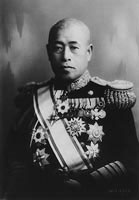
Admiral
Yamamoto (1884-1943). |
|
Admiral
Yamamoto was credited with planning the Japanese attack on Pearl
Harbor on Dec. 7, 1941.
The Admiral
was killed in an ambush in the South Pacific in 1943. The Roosevelt
Reich Navy had broken the Japanese naval code long before Pearl
Harbor and knew EVERY move that the Admiral and the Japanese Navy
were making.
"One
of the most important Japanese Catholics in this period was Admiral
Yamamoto who was the first convert to Catholicism in 1893 at the
French Marianists' School in Japan. He had traveled widely, especially
in Europe. In early 1938 Yamamoto had told friends in Rome that
conflict between Japan and the United States was inevitable because
of the clash of races and of commercial interests; that Japan
was preparing for war; and when the first blow would be struck.
it would be a terrific one."(Quigley, Peace
without Hiroshima, p. 75). |
Admiral Yamamoto
was the son of a poor school teacher from the village of Kushigun, Sonshomura.
His father Sadakichi, was fifty-six years old when his 7th son was born
so he named him Isoroku (fifty-six) in Japanese characters. Yamamoto
had no royal blood and certainly no money but he rose to command the
Combined Japanese Fleet.
Money was no object
to the Jesuits however who were trying to reestablish a beachhead in
Japan since there expulsion in 1607. Yamamoto was placed in charge of
the Combined Japanese Fleet in 1939 and promoted to Admiral in 1940.
Japan
was supposed to attack Russia in 1941
|
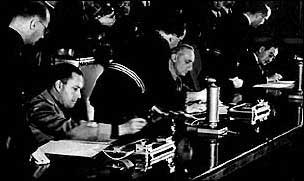
In Sept. 1940,
Japan, Italy and Germany signed the Tripartite Pact.
|
|
In
the Spring of 1941, Hitler was ready to invade the Soviet Union
with the largest invasion force in the history of the world. This
invasion force was supplied with oil by the Rockefeller owned
Standard Oil Co., and trucks by the Ford Motor Co.
While
Hitler attacked from the West, Japan was supposed to attack Russia
from the East.
The Japanese
were afraid to attack Russia because they had a very healthy respect
for the Red Army after the Russians annihilated a Japanese army
in Manchuria in August 1939. Hitler never sent observers to that
battle because he had nothing but disdain for the fighting ability
of the Red Army.
|
Roosevelt
was FURIOUS when Japan failed to attack Russia!!
Fuehrer Franklin
was furious when Japan refused to attack Russia. His advisers told him
that unless Japan opened a second front in the East, the Nazi hordes
would be swallowed up in the vastness of Russia and Hitler might lose
the war.
He also needed a
war in order to serve a fourth and fifth term as President. This would
allow him to pack the Supreme Court with his cronies in order to destroy
the Constitution. He
maneuvered the Japanese into attacking the U.S. Pacific Fleet at Pearl
Harbor and Japan and the U.S. were at war . . . instead of Japan and
Russia. In
May, 1940, Roosevelt ordered the U.S. fleet moved from its headquarters
in California to Pearl Harbor. The Navy had was already listening in
on Japanese naval traffic:
"During
the last days of September and first week of October 1940, a team of
Army and Navy cryptographers solved the two principal Japanese government
code systems: Purple, the major diplomatic code, and portions of the
Kaigun Ango, a series of twenty-nine separate Japanese naval operational
codes used for radio contact with warships, merchant vessels, naval
bases, and personnel in overseas posts, such as naval attachés.
Much has been made of the Purple Code and far too little of the navy
codes. Historians have made misleading references to the Purple Code
by confusing its use and purpose. It was used solely by the Japanese
Foreign Ministry for encoding diplomatic messages dispatched by radio
between Tokyo and selected overseas embassies and consulates. In the
United States, Japan issued the Purple system to its Washington embassy
and to its consulate in Manila, but not to the Honolulu consulate. The
Purple Code was never used by the Japanese Navy. (Stinnett, Day
of Deceit: the Truth about FDR and Pearl Harbor, p. 21)
The Japanese took
the bait and attacked Pearl Harbor on Dec. 7, 1941. Roosevelt had his
war at last.
Japan
established diplomatic relations with the Vatican in 1942
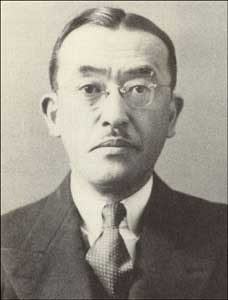
Ken Harada,
Japanese ambassador to the Vatican. |
|
Japan
established diplomatic relations with Vatican city in 1942. The
first ambassador's name was Ken Harada:
"Among
the inhabitants of Vatican City at that time were the members
of the small Japanese Mission to the Holy See. When the Holy See
and Japan entered upon a form of diplomatic relations in 1942
the war was already three years old in Europe and Pearl Harbor
had already been attacked. Negotiations between Vatican representatives
and the Japanese Government looking to the establishment of relations
had been carried on sporadically for a couple of decades. War
conditions, however, had convinced the Japanese of the need of
representation at the famed "listening post." (Quigley,
Peace without Hiroshima, p. 7). |
Japanese
Emperor was considered a direct descendant of the sun goddess
Like the Pope at
Rome who is the earthy representative of Circe, Cybele or Diana of the
Ephesians, the Japanese Emperor was considered the earthy representative
of the great mother goddess:
| 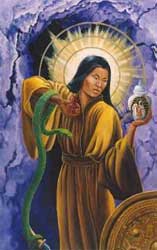
Amaterasu
The sun goddess
Amaterasu. The Emperor was considered a direct descendant of this
sun goddess. Japan is unique because the false mother goddess
was always associated with the MOON.
|
|
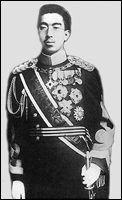
Emperor Hirohito
(1901-1989).
The
Japanese Emperor was considered the direct descendant of the
sun goddess. He was held in as much esteem as the Roman Catholics
hold the Pope. To kill the Emperor was like killing god. Unconditional
surrender was considered a threat to the life of the Emperor.
|
Roosevelt's
"unconditional surrender" imperiled the life of the Emperor!!
In
1943 at Casablana, Roosevelt changed the surrender terms to "unconditional
surrender." He knew that this would prolong the war and give him
more time in the White House. Here is an excerpt from the book The
Decision to Use the Bomb:
"The
standing U.S. demand for "unconditional surrender"
directly threatened not only the person of the Emperor but such
central tenets of Japanese culture as well. Because of the Emperor's
unique political and religious status, U.S. leaders were repeatedly
advised of three related but quite distinct points:
First, a
surrender would likely be accepted only if the Japanese people
were assured the Emperor-God would neither be removed from his
throne nor harmed (or tried and possibly hanged as a war criminal,
as German leaders were about to be tried).
Second,
even more important, U.S. leaders were advised that if such
assurances were not given, the Japanese would likely fight to
the last man. Very few Japanese units had surrendered in the
bloody island fighting, and there was ample evidence that the
Japanese soldier was prepared to die for the Emperor. The U.S.
military understood that if no assurances for the Emperor were
given—whether called "conditions" or not—it
would almost certainly mean a struggle to the death.
Third, the
president and his chief advisers were counseled that the Emperor
would play a critical role in maintaining internal order in
postwar Japan-and, indeed, in helping head off the possibility
of chaos or even Communist-inspired revolutionary attempts.9The
"unconditional" language had originally been adopted
almost accidentally by Roosevelt at the January 1943 Casablanca
conference. Cordell Hull recalled that it had not, in fact,
originally been part of State Department strategy: "We
were as much surprised as Mr. Churchill when, for the first
time, the President, in the Prime Minister's presence, stated
it suddenly to a press conference."
The formula
proved to be controversial not only because of its uncompromising
tone but also, ironically, because of its ambiguity. At Casablanca,
Roosevelt seemingly qualified his position at the same time
he defined it when he stated that "unconditional surrender"
did not mean the destruction of the peoples of Germany, Japan,
and Italy; rather, it meant the destruction of the "philosophy"
which had brought about world war. Given the importance of religious
ideas in their political culture, of course, this was equally
threatening to Japanese leaders.
Roosevelt further complicated matters when in an address to
White House press correspondents on February 12, 1943, he affirmed
the policy in a way which now seemed to threaten the Emperor's
person:
The only
terms on which we shall deal ... are the terms proclaimed
at Casablanca: "unconditional surrender." In our
uncompromising policy we mean no harm to the common people
of the Axis nations. But we do mean to impose punishment and
retribution in full upon their guilty, barbaric leaders."
The original
announcement of the surrender demand had jolted not only Japan
but many knowledgeable American policy-makers. Japanese propaganda
had moved quickly to rally support for the war by predicting
Japan's complete and absolute destruction under "unconditional
surrender." Numerous officials in Washington understood
the difficulties the formula presented, and several actively
began to search for ways to modify and soften its impact. (Alperovitz,
The Decision to Use the Bomb, pp. 36-37).
|
The Pope wanted
to get rid of the Japanese Imperial Dynasty!!
The
Vatican was secretly praying for an end of the Japanese Imperial
Dynasty. That was what was behind the unconditional surrender
terms of Roosevelt.
The
Emperor of Japan was more than a political ruler. Like the Pope at
Rome, he represented the false goddess to his people. The Japanese
people were patriotic however because they did not look to a foreigner
as their political or religious ruler. That made the Emperor a competitor
to the Vatican. Leahy, Groves and Byrnes allowed the Emperor to stay
because they needed a quick surrender in order to prevent a Soviet
invasion of Japan.
Ambassador Harada
sent several peace messages to Tokyo
In
a typical Machiavellian maneuver, the Vatican made war on the Japanese
through their boys Leahy, Groves and Byrnes while at the
same time helping them to surrender:
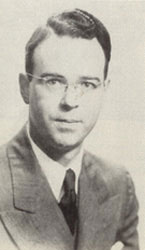
Martin
S. Quigley. Secret agent for the O.S.S. in Vatican City.
|
|
Martin
S. Quigley was a secret agent for the O.S.S. —Office of
Strategic Services founded by William (Wild Bill) Donovan. He
was instructed to contact the Japanese Papal ambassador about
negotiating the surrender of Japan.
He dealt
with several high ranking members of the hierarchy including
Monsignor Ottaviani later to become Cardinal Ottaviani.
The messages
were sent via Vatican radio to Switzerland and then relayed
to Tokyo. The messages were decoded and read in Washington the
next day.
No replies
from Tokyo were received unless the messages were intercepted.
This way at least the Vatican could gain sympathy from Japan
by trying to stop the atomic bombing of Hiroshima and
Nagasaki. |
Here
is an excerpt from the book by Martin S. Quigley:
The
Vatican radio official saw that the message comprised three
typed pages and remarked that it probably would not be broadcast
for a couple of hours in view of the backlog. Watanabe urged
that Harada's message should be sent out as soon as possible
as it was a priority communication to the Foreign Minister.
As he walked out of the radio office, the Japanese
"At
that period the Vatican Radio was operating with relatively
dated equipment installed years before the war. It lacked
the power to transmit direct to Tokyo. The Japanese, of
course, knew this. All along they had been using a modern
and very powerful installation at their Embassy in Berne,
Switzerland, not only for traffic from there but for relaying
messages from their missions in Sweden and Spain, as well
as the few originating at the Vatican.
That
afternoon an operator at the Japanese Embassy in Berne picked
up and recorded the Harada message. It was promptly rebroadcast.
The transmission was automatically recorded at the Foreign
Office's communications center in Japan. Within a matter
of minutes the message was played back to a specialist in
decrypting and then run through the decoding machine which
printed out the words in Japanese. A copy was made for the
files of the center and the original was sealed in an envelope;
it was then given to a dispatch carrier who took it by motorcycle
to the Foreign Office. There it was signed for at the message
desk. In a few moments another messenger took it to the
office of the secretary to the Foreign Minister.
As the
Berne transmission was crackling through the atmosphere,
it was recorded in England simultaneously with its recording
in Tokyo. As it was identified as being in a Japanese code—the
huge establishment concentrated on German messages—the
Japanese message was sent on at once to the United States.
This division of decoding labors was one of the smoothest
in British-American military relations.
In
Washington at Arlington Hall, an exclusive girls school until
taken over by the government, over a thousand extremely bright
men and women worked in one of the most "hush hush"
organizations of the wartime military establishment. Physical
conditions were cramped and there was never enough space for
comfortable working arrangements because the staff was constantly
expanding to handle the mounting volume of Japanese intercepts.
Decrypting
and decoding are among the most arcane of human activities.
Even with the aid of sophisticated machines, they call upon
a host of intellectual talents and, as some believed, a
measure of wizardry. Having started the war with a handful
of specialists in this area—veterans of the era when,
as Secretary of War Stimson had put it, "gentlemen
do not read other people's mail"—the military
had to recruit extensively"
(Quigley, Peace without Hiroshima, pp. 124-125).
|
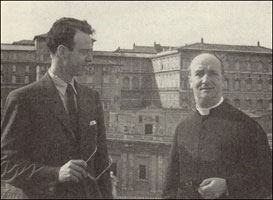
Martin S. Quigley
and Monsignor (later Cardinal) Ottaviani) in front of the Papal Palace.
To
be continued
References
Agawa,
Hiroyuki. The Reluctant Admiral: Yamamoto and the Imperial Navy.
Kodansha Intl., Tokyo, 1979.
Alperovitz,
Gar. The Decision to Use the Bomb. Alfred A. Knopf, New York
1995.
Potter,
John Deane. Yamamoto The Man who Menaced America. Viking Press,
New York, 1965.
Stinnett,
Robert B. Day of Deceit: the Truth about FDR and Pearl Harbor,
Free Press (a division of Simon & Schuster Inc.), New York, 2000.
Quigley,
Martin S. Peace without Hiroshima: Secret Actions at the Vatican
in Spring of 1945. Madison Books, Lanham, Maryland, 1991.
Back
to Main Menu
|






